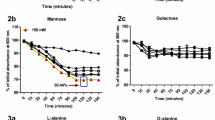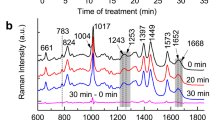Abstract
Gramicidin S is known to prolong the outgrowth stage of spore germination in the producing culture. Bacillus brevis strain Nagano and its gramicidin S-negative mutant, BI-7, were compared with respect to cell-surface hydrophobicity and germination of their spores. Parental spores were hydrophobic as determined by adhesion to hexadecane, whereas mutant spores showed no affinity to hexadecane. Addition of gramicidin S to mutant spores resulted in a high cell surface hydrophobicity and a delay in germination outgrowth. The hydrophobicity of parental spores was retained throughout most of the germination period. Hydrophobicity was lost as outgrowing spores entered into the stage of vegetative growth. The data indicate that gramicidin S is responsible for the hydrophobicity of B. brevis spores. It is suggested that in making spores hydrophobic, the antibiotic plays a role in concentrating the spores at interfaces where there is a higher probability of finding nutrients for germination and growth.
Similar content being viewed by others
Abbreviations
- GS:
-
Gramicidin S
References
Daher E, Demain AL (1985) Germination-initiated spores of Bacillus brevis Nagano retain their resistance properties. J Bacteriol 161:47–50
Dahlback B, Hermannson M, Kjelleberg S, Norkrans B (1981) The hydrophobicity of bacteria — an important factor in their initial adhesion at air-water interface. Arch Microbiol 128:267–270
Damain AL (1980) Do antibiotics function in nature? Search II:148–151
Demain AL, Piret JM (1970) Relationship between antibiotic biosynthesis and sporulation. In: Luckner M, Schreiber K (eds) Regulation of secondary product and plant hormone metabolism. Pergamon Press, New York, pp 183–188
Egorov NS, Vyipiyach AN, Zharikova GG, Maksimov VN (1975) Effect of various factors on spore germination in S and P-variants of Bacillus brevis. Mikrobiologiya 44:237–240
Gaudin AM, Mular AL, O'Connor RF (1960) Separation of microorganisms by flotation. Appl Microbiol 8:91–97
Iwaki M, Shimura K, Kanda M, Kaji E, Saito Y (1972). Some mutants of Bacillus brevis deficient in gramicidin S formation. Biochem Biophys Res Commun 48:113–118
Katz E, Demain AL (1977) The peptide antibiotics of Bacillus: chemistry, biogenesis and possible functions. Bacteriol Rev 41:449–474
Krauss EM, Chan IS (1983) Complexation and phase transfer of nucleotides by gramicidin S. Biochemistry 22:4280–4291
Krauss EM, Chan IS (1984) Complexation and phase transfer of nucleic acids by gramicidin S. Biochemistry 23:73–77
Kurotsu T, Marahiel MA, Muller KD, Kleinkauf H (1982) Characterization of an intracellular serine protease from sporulating cells of Bacillus brevis. J Bacteriol 151:1466–1472
Lazaridis I, Frangou-Lazaridis M, MacCuish FC, Nandi S, Seddon B (1980) Gramicidin S content and germination and outgrowth of Bacillus brevis spores. FEMS Microbiology Lett 7:229–232
Lipmann F (1973) Nonribosomal polypeptide synthesis on polyenzyme templates. Accounts Chem Res 6:361–367
Marahiel M, Danders W, Krause M, Kleinkauf H (1979) Biological role of gramicidin S in spore functions. Studies on gramicidin S-negative mutants of Bacillus brevis ATCC 9999. Eur J Biochem 99:49–55
Marshall KC (1976) Interfaces in microbial ecology. Harvard University Press, Cambridge, MA
Matteo CC, Glade M, Tanaka A, Piret JM, Demain AL (1975) Microbiological studies on the formation of gramicidin S synthetases. Biotechnol Bioeng 17:129–142
Nandi S, Seddon B (1978) Evidence of gramicidin S functioning as a bacterial hormone specifically regulating spore outgrowth in Bacillus brevis strain Nagano. Biochem Soc Trans 6:409–411
Piret JM, Demain AL (1982) Germination initiation and outgrowth of spores of Bacillus brevis strain Nagano and its gramicidin S-negative mutant. Arch Microbiol 133:38–43 (1982)
Piret JM, Demain AL (1983) Sporulation and spore properties of Bacillus brevis and its gramicidin S-negative mutant. J Gen Microbiol 129:1309–1319
Rosenberg M, Rosenberg E (1981) Role of adherence in growth of Acinetobacter calcoaceticus on hexadecane. J Bacteriol 148: 51–57
Rosenberg M, Rosenberg E, Gutnick D (1980) Bacterial adherence to hydrocarbons. In: Berkeley RCW, Lynch JM, Melling J, Rutter PR, Vincent B (eds) Microbial adhesion to surfaces. Society of Chemical Industry. London, pp 541–542
Sacks LE, Alderton G (1961) Behavior of bacterial spores in aqueous polymer two-phase systems. J Bacteriol 82:331–341
Shoham Y, Rosenberg M, Rosenberg E (1983) Bacterial degradation of emulsan. Appl Environ Microbiol 46:573–579
Author information
Authors and Affiliations
Rights and permissions
About this article
Cite this article
Rosenberg, E., Brown, D.R. & Demain, A.L. The influence of gramicidin S on hydrophobicity of germinating Bacillus brevis spores. Arch. Microbiol. 142, 51–54 (1985). https://doi.org/10.1007/BF00409236
Received:
Accepted:
Issue Date:
DOI: https://doi.org/10.1007/BF00409236




